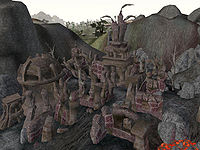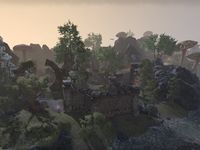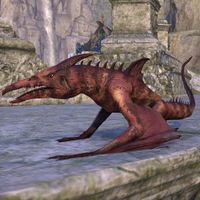Lore:Bal Ur
| Bal Ur | |
|---|---|
| Type | Daedric Ruin |
| Continent | Tamriel |
| Province | Morrowind |
| Region | Molag Amur |
| Appears in | Morrowind, ESO |

Contents
Bal Ur is a ruin found in Molag Amur, located in southern Vvardenfell. The site is notable for being considered by the Tribunal Temple as the birthplace of the Daedric Prince of Domination, Molag Bal.[1]
History[edit]
The ruins of Bal Ur have been contested throughout history, as it is considered by some as the birthplace of Molag Bal. To the Tribunal Temple, it is a pilgrimage site those of the Diviner rank must visit as part of the Pilgrimages of the Four Corners. For Molag Bal is one of the Four Corners of Trouble, the "bad daedra" in Dunmeri culture.[2] To vampires, Molag Bal is considered a progenitor of vampires and consider it a site important to their vampiric heritage.[3] It was also the site of worship for the Chimer prior to the rise of the Tribunal. Within Bal Ur was one of the seven Stones of Cold Fire, artifacts gifted directly from Molag Bal and distributed throughout Vvardenfell's daedric ruins that were dedicated to Molag Bal. These stones held the power to summon and compel daedra.[4]
Sometime in the Second Era, Buoyant Armigers were garrisoned within the pilgrimage site. Unfortunately, the vampires of the Aundae Clan were on a conquest, aggressively seeking to reclaim locations important to their vampire heritage. Seeing the presence of the Armigers in the site angered the clan, and they ambushed and slew most of the Armigers before they were able to draw their weapons. One of the survivors was Galur Rithari, who was used as cattle and eventually turned. Galur would leave the site, seeking a cure for this curse.[3]
By 2E 582, the Audane Clan temporarily withdrew, and the site's exterior had become inhabited by the Iron Hound bandits who terrorized the nearby areas such as the town of Suran.[5] After a near-death experience caused premonitions foretelling the return of Dagoth Ur and his Sixth House, Mistress Dratha in an effort to play a role in the rise of the Nerevarine, sought to extend her life. She sent a hireling of Great House Telvanni to Bal Ur to retrieve its Stone of Cold Fire, to use in a ritual to summon and bargain with the Xykenaz to be granted immortality.[4]
Eventually, Galur would return to Bal Ur to enact revenge on the Aundae Clan who took residence once again. He began to prey upon its inhabitants, hoping to atone for his sins as a vampire or to perish by their hands. By chance, deep within the ruin's cavern, he made a petition to Molag Bal, who responded to his call. The prince demanded a cursed soul gem of a mysterious nature from a deep cavern on the northern slopes of Dagoth Ur. When he retrieved it, he placed the gem within the basin before Molag Bal's altar, and instantly experienced blinding of such pain and terror that it cannot be expressed in words. It was seemingly a dream, where he was being sliced by thousands of tiny knives from his bowels inside out. Galur awoke before the altar, and gazed into the reflection of his sword blade, and looked at his face, relieved to no longer be a creature of the night.[6]
Galur would create write a series of manuscripts in his efforts to inform others of the cure for vampirism. Unfortunately, this was met with hostility from the Tribunal Temple, who imprisoned him on the grounds of heresy and banned his writings. Due to the ban on his manuscripts, they became a highly sought-after collector's item, and the cure he sought so long for faded to obscurity.[1] People who find one of his manuscripts would find that Molag Bal's shrine in Bal Ur may yield a cure for Vampirism in return for completing a task, should Molag Bal respond to his summons.[7]
Circa 3E 427, the shrine became inhabited by hostile cultists and daedra, impeding any seeking to complete their temple pilgrimages, or seeking to cure their vampirism.[8]
Gallery[edit]
Notes[edit]
- The ruin is the namesake of the region, Bal Ur, which is completely inhospitable. The Ashlanders only come here to hunt, but beyond that, only outlaws and ashlander outcasts lived in the region.[9]
See Also[edit]
- For game-specific information, see the Morrowind and Elder Scrolls Online
 articles.
articles.
References[edit]
- ^ a b Vampires of Vvardenfell
- ^ Molag Bal of the House of Troubles quest in Morrowind
- ^ a b Ongoing Journal of Galur Rithari — Galur Rithari
- ^ a b At Any Cost quest in ESO: Morrowind
- ^ The Scarlet Judge quest in ESO: Morrowind
- ^ Galur Rithari's Papers — Galur Rithari
- ^ A Cure for Vampirism quest in Morrowind
- ^ Bal Ur's appearance in Morrowind
- ^ Bal Ur Region description in Morrowind

